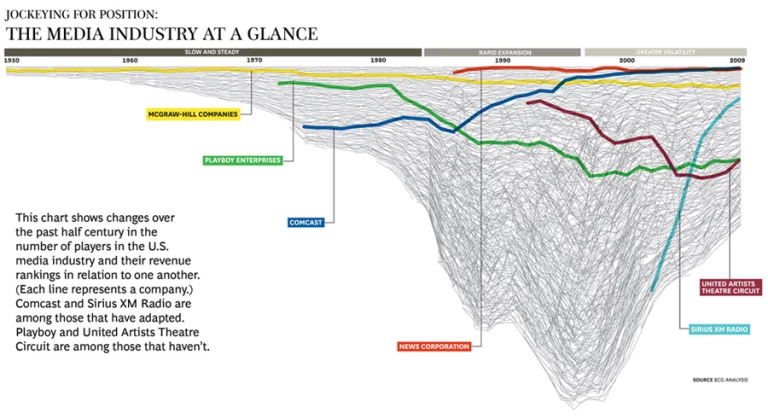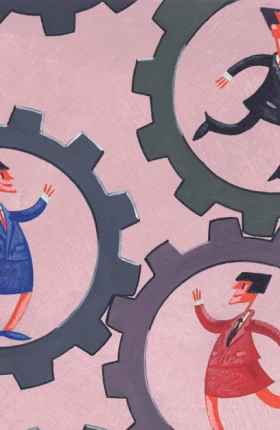Globalization, new technologies, and greater transparency have combined to upend the business environment and give many CEOs a deep sense of unease. Just look at the numbers. Since 1980 the volatility of business operating margins, largely static since the 1950s, has more than doubled, as has the size of the gap between winners (companies with high operating margins) and losers (those with low ones).
Market leadership is even more precarious. The percentage of companies falling out of the top three rankings in their industry increased from 2% in 1960 to 14% in 2008. What’s more, market leadership is proving to be an increasingly dubious prize: The once strong correlation between profitability and industry share is now almost nonexistent in some sectors. According to our calculation, the probability that the market share leader is also the profitability leader declined from 34% in 1950 to just 7% in 2007. And it has become virtually impossible for some executives even to clearly identify in what industry and with which companies they’re competing.
All this uncertainty poses a tremendous challenge for strategy making. That’s because traditional approaches to strategy—though often seen as the answer to change and uncertainty—actually assume a relatively stable and predictable world.
Think about it. The goal of most strategies is to build an enduring (and implicitly static) competitive advantage by establishing clever market positioning (dominant scale or an attractive niche) or assembling the right capabilities and competencies for making or delivering an offering (doing what the company does well). Companies undertake periodic strategy reviews and set direction and organizational structure on the basis of an analysis of their industry and some forecast of how it will evolve.
But given the new level of uncertainty, many companies are starting to ask:
- How can we apply frameworks that are based on scale or position when we can go from market leader one year to follower the next?
- When it’s unclear where one industry ends and another begins, how do we even measure position?
- When the environment is so unpredictable, how can we apply the traditional forecasting and analysis that are at the heart of strategic planning?
- When we’re overwhelmed with changing information, how can our managers pick up the right signals to understand and harness change?
When change is so rapid, how can a one-year—or, worse, five-year—planning cycle stay relevant?
The answers these companies are coming up with point in a consistent direction. Sustainable competitive advantage no longer arises exclusively from position, scale, and first-order capabilities in producing or delivering an offering. All those are essentially static. So where does it come from? Increasingly, managers are finding that it stems from the “second-order” organizational capabilities that foster rapid adaptation. Instead of being really good at doing some particular thing, companies must be really good at learning how to do new things.
Those that thrive are quick to read and act on signals of change. They have worked out how to experiment rapidly, frequently, and economically—not only with products and services but also with business models, processes, and strategies. They have built up skills in managing complex multi-stakeholder systems in an increasingly interconnected world. Perhaps most important, they have learned to unlock their greatest resources—the people who work for them. In the following pages we’ll look at how companies at the leading edge are using these four organizational capabilities to attain adaptive advantage. We’ll also discuss the implications of this fundamental strategic shift for large, established corporations, many of which have built their operations around scale and efficiency—sources of advantage that rely on an essentially stable environment.
The Ability to Read and Act on Signals
In order to adapt, a company must have its antennae tuned to signals of change from the external environment, decode them, and quickly act to refine or reinvent its business model and even reshape the information landscape of its industry.
Think back to when Stirling Moss was winning Formula One car races: The car and the driver determined who won. But today the sport is as much about processing complex signals and making adaptive decisions as about mechanics and driving prowess. Hundreds of sensors are built into the cars; race teams continuously collect and process data on several thousand variables—ranging from weather and road conditions to engine rpm and the angles of curves—and feed them into dynamic simulation models that guide the drivers’ split-second decisions. A telemetric innovation by one team can instantly raise the bar for all.
In this information-saturated age, when complex, varying signals may be available simultaneously to all players, adaptive companies must similarly rely on sophisticated point-of-sale systems to ensure that they acquire the right information. And they must apply advanced data-mining technologies to recognize relevant patterns in it.
For example, a leading media company that was suffering from a high rate of customer churn revamped its analytic approach to customer data, applying “neural network” technologies in order to understand patterns of customer loss. The company found hidden relationships among the variables that were driving churn and launched retention campaigns targeting at-risk customers. The accuracy rate in predicting churn was an impressive 75% to 90%—a huge benefit, given that every percentage point in churn reduction added millions of dollars to the bottom line.
Companies are also leveraging their signal-reading capabilities to make operational interventions in real time, bypassing slow-moving decision hierarchies. The UK-based grocery retailer Tesco continually performs detailed analyses of the purchase patterns of the more than 13 million members of its loyalty-card program. Its findings enable Tesco to customize offerings for each store and each customer segment and provide early warning of shifts in customer behavior. They also supported the development of Tesco’s hugely successful online platform, which has extended the company’s business model, enabling Tesco to become a store without walls and to offer a broader range of products and services, including media and financial services. To put the icing on the cake, instead of being purely a cost center, the rich databases and analytical capabilities produce a stream of direct revenue: For a fee, Tesco allows other enterprises to access its technologies and insights.
Google is another example. It uses algorithms to update the position of an ad on the basis of the ad’s relevance to an individual search or website as well as the advertiser’s bids on key words. The more relevant an ad, the higher the click-through rate—and because advertisers pay per click, this means more revenue for Google. By linking its advertising data directly to its operations, Google can respond to changing ad conditions on a split-second basis, without the intervention of human decision makers.
The Ability to Experiment
That which cannot be deduced or forecast can often be discovered through experimentation. Of course, all companies use some form of experimentation to develop and test new products and services. Yet the traditional approaches can be costly and time-consuming, and may saddle the organization with an unreasonable burden of complexity. Furthermore, research based on consumers’ perceptions is often a remarkably poor predictor of success. The real world is an expensive medium for experimentation, and failed market-facing tests and pilots may jeopardize a company’s brand and reputation.
To overcome these barriers, a growing number of adaptive competitors are using an array of new approaches and technologies, especially in virtual environments, to generate, test, and replicate a larger number of innovative ideas faster, at lower cost, and with less risk than their rivals can. Procter & Gamble is a case in point. Through its Connect + Develop model, it leverages InnoCentive and other open-innovation networks to solve technical design problems. It uses a walk-in, 3-D virtual store to run experiments that are quicker and cheaper than traditional market tests. And by employing Vocalpoint and other online user communities, it can introduce and test products with friendly audiences before a full launch. In 2008 alone, 10 highly skilled employees were able to generate some 10,000 design simulations, enabling the completion in hours of mock-ups that might once have taken weeks. More than 80% of P&G’s new-business initiatives now make use of its growing virtual toolbox.
In addition to changing the way in which they conduct experiments, companies need to broaden the scope of their experimentation. Traditionally, the focus has been on a company’s offerings—essentially new products and services. But in an increasingly turbulent environment, business models, strategies, and routines can also become obsolete quickly and unpredictably. Adaptive companies therefore use experimentation far more broadly than their rivals do. We’ve seen that Tesco illustrates the power of experimenting with business models as well as with product range.
Ikea, like Tesco, leverages existing assets and capabilities to experiment with business models. After the company entered Russia, managers noticed that whenever it opened a store, the value of nearby real estate increased dramatically. So Ikea decided to explore two business models simultaneously: retailing through its stores and capturing the appreciation in real estate values through mall development. It now makes more profit in Russia from developing and operating malls than from its traditional retail business.
Finally, experimentation necessarily produces failure. Adaptive companies are very tolerant of failure, even to the point of celebrating it. For example, the software company Intuit, which has been extremely successful at using adaptive approaches to grow new businesses, launched a marketing campaign in 2005 to reach young tax filers through a website called rockyourrefund.com. The site offered discounts at Expedia and Best Buy and the opportunity to get tax refunds in the form of prepaid gift cards. The campaign was a flop, and practically no one used the site. The amount of money involved was negligible—“almost a rounding error,” says Rick Jensen, the vice president of product management for Intuit’s consumer tax division. But the marketing team documented what it had learned from the failure and won an award from company chairman Scott Cook, who said, “It is only a failure if we fail to get the learning.”
The Ability to Manage Complex Multicompany Systems
Signal detection and experimentation require a company to think beyond its own boundaries and perhaps to work more closely and smartly with customers and suppliers. This flies somewhat in the face of the unspoken assumption that the unit of analysis for strategy is a single company or business unit.
With an increasing amount of economic activity occurring beyond corporate boundaries—through outsourcing, offshoring, value nets, value ecosystems, peer production, and the like—we need to think about strategies not only for individual companies but also for dynamic business systems. Increasingly, industry structure is better characterized as competing webs or ecosystems of codependent companies than as a handful of competitors producing similar goods and services and working on a stable, distant, and transactional basis with their suppliers and customers.
In such an environment advantage will flow to those companies that can create effective strategies at the network or system level. Adaptive companies are therefore learning how to push activities outside the company without benefiting competitors and how to design and evolve strategies for networks without necessarily being able to rely on strong control mechanisms.
Typically, adaptive companies manage their ecosystems by using common standards to foster interaction with minimal barriers. They generate trust among participants—for example, by enabling people to interact frequently and by providing transparency and rating systems that serve as “reputational currency.” Toyota’s automotive supply pyramids, with their kanban and kaizen feedback mechanisms, are early examples of adaptive systems. EBay’s complex network of sellers and buyers is another; the company relies on seller ratings and online payment systems to support the online marketplace.
If the experience curve and the scale curve were the key indicators of success, Nokia would still be leading the smartphone market; it had the advantage of being an early mover and the market share leader with a strong cost position. But Nokia was attacked by an entirely diff erent kind of competitor: Apple’s adaptive system of suppliers, telecom partnerships, and numerous independent application developers, created to support the iPhone. Google’s Android operating system, too, capitalized on a broad array of hardware partners and application developers. The ability to bring together the assets and capabilities of so many entities allowed these smartphone entrants to leapfrog the experience curve and become new market leaders in record time. As Stephen Elop, Nokia’s CEO, wrote in a memo to his staff , “Our competitors aren’t taking our market share with devices; they are taking our market share with an entire ecosystem.” Through broader signal detection, parallel innovation, superior flexibility, and rapid mobilization, multicompany systems can enhance the adaptiveness of individual companies.
The Ability to Mobilize
Adaptation is necessarily local in nature—somebody experiments first at a particular place and time. It is also necessarily global in nature, because if the experiment succeeds, it will be communicated, selected, amplified, and refined. Organizations therefore need to create environments that encourage the knowledge flow, diversity, autonomy, risk taking, sharing, and flexibility on which adaptation thrives. Contrary to classical strategic thinking, strategy follows organization in adaptive companies.
A flexible structure and the dispersal of decision rights are powerful levers for increasing adaptability. Typically, adaptive companies have replaced permanent silos and functions with modular units that freely communicate and recombine according to the situation at hand. To reinforce this framework, it is helpful to have weak or competing power structures and a culture of constructive conflict and dissent. Cisco is one company that has made this transformation. Early on, it relied on a hierarchical, customercentric organization to become a leader in the market for network switches and routers. More recently the CEO, John Chambers, has created a novel management structure of cross-functional councils and boards to facilitate moves into developing countries and 30 adjacent and diverse markets (ranging from health care to sports) with greater agility than would previously have been possible.
As they create more-fluid structures, adaptive companies drive decision making down to the front lines, allowing the people most likely to detect changes in the environment to respond quickly and proactively. For example, at Whole Foods the basic organizational unit is the team, and each store has about eight teams. Team leaders—not national buyers—decide what to stock. Teams have veto power over new hires. They are encouraged to buy from local growers that meet the company’s quality and sustainability standards. And they are rewarded for their performance with bonuses based on store profitability over the previous four weeks.
Creating decentralized, fluid, and even competing organizational structures destroys the big advantage of a rigid hierarchy, which is that everyone knows precisely what he or she should be doing. An adaptive organization can’t expect to succeed unless it provides people with some substitute for that certainty. What’s needed is some simple, generative rules to facilitate interaction, help people make trade-offs, and set the boundaries within which they can make decisions.
For example, Netflix values nine core behaviors and skills in its employees: judgment, communication, impact, curiosity, innovation, courage, passion, honesty, and selflessness. The company’s executives believe that a great workplace is full of “stunning colleagues” who embody these qualities; thus the Netflix model is to “increase employee freedom as we grow, rather than limit it, to continue to attract and nourish innovative people, so we have a better chance of long-term continued success.” Consistent with this philosophy, Netflix has only two types of rules: those designed to prevent irrevocable disaster and those designed to prevent moral, ethical, and legal issues. It has no vacation policy and does no tracking of time—the company’s focus is on what needs to get done, not how many hours or days are worked. As the Netflix “Reference Guide on Our Freedom & Responsibility Culture” puts it, “Avoid Chaos as you grow with Ever More High Performance People—not with Rules.”
The Challenge for Big Business
Becoming an adaptive competitor can be difficult, especially for large, established organizations. Typically, these companies are oriented toward managing scale and efficiency, and their hierarchical structures and fixed routines lack the diversity and flexibility needed for rapid learning and change. Such management paradigms die hard, especially when they have historically been the basis for success.
However, several tactics have proved effective at fostering adaptive advantage even in established companies. To the managers involved, they may look like nothing more than an extension of business as usual, but in fact they create a context in which adaptive capabilities can thrive. If you are the CEO of a large company that wants to be more adaptive, challenge your managers to:
Look at the mavericks. Fast-changing industries are characterized by the presence of disruptive mavericks—often entirely new players, sometimes from other sectors. Ask your managers to shift their focus from traditional competitors’ moves to what the new players are doing and to think of ways to insure your company against this new competition or neutralize its effect. They should also look at what’s happening in adjacent or analogous industries and markets and ask, “What if this happened in mine?” Although pattern recognition is harder in an uncertain environment and can easily be obstructed by entrenched beliefs and narrow industry definitions, it has tremendous competitive value.
Identify and address the uncertainties. Get your managers to put aside the traditional single-business forecast and instead examine the risks and uncertainties that could significantly affect the company. This simple extension of the familiar long-range strategy exercise can force people to realize what they don’t yet know and to address it. Your organization needs to distinguish “false knowns” (questionable but firmly held assumptions) from “underexploited knowns” (megatrends you may recognize and perhaps have even acted on, but without sufficient speed or emphasis) and “unknown unknowns” (intrinsic uncertainties that you can prepare for only by hedging your bets).
Put an initiative on every risk. Most companies have a portfolio of strategic initiatives. It should become the engine that drives your organization into adaptability—and it can, with a couple of simple enhancements. First, every significant source of uncertainty should be addressed with an initiative. Depending on the nature of the uncertainty, the goal of the initiative may be responding to a neglected business trend, creating options for responding to it down the line, or simply learning more about it. In managing these initiatives, your company should be as disciplined with metrics, time frames, and responsibilities as it would be for the product portfolio or the operating plan.
Examine multiple alternatives. In a stable environment it is sufficient to improve what already exists or to examine single change proposals. The simple step of requiring that every change proposal be accompanied by several alternatives not only surfaces a more varied and powerful set of moves, but also legitimizes and fosters cognitive diversity and organizational flexibility.
Increase the clock speed. The speed of adaptation is a function of the cycle time of decision making. In a fast-moving environment, companies need to accelerate change by making annual planning processes lighter and more frequent and sometimes by making episodic processes continual.
The adaptive approach is no universal panacea. If your industry is stable and relatively predictable, you may be better off sticking to the traditional sources of advantage. But if your competitive reality is uncertain and rapidly changing, as is true in an increasing number of industries, you need a dynamic and sustainable way to stay ahead. Your survival may depend on building an organization that can exploit the four capabilities behind what we think of as adaptive advantage.
This article originally appeared in the Harvard Business Review and is republished here with permission.







